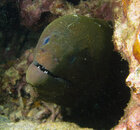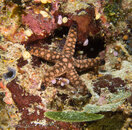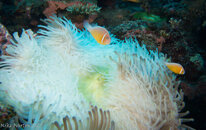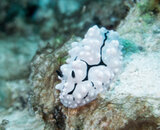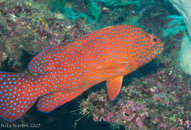I see this post is a few months old but figured I'd weigh in, as there is very little detailed info on using Nikon 1 systems underwater despite the good manufacturer housings. I've been using a Nikon 1 S1 in WP-N2 housing obtained for a similar deal many years ago, basically just a newer J1, same sensor though some features may have changed. This generally applies to all the Nikon 1 cameras (J1, J2, J3, J4, J5, S1, S2, V1, V2, V3, AW1) and Nikon 1 housings (WP-N1, WP-N2; the WP-N3 fits different lenses) except certain features that differ on the V series (no Nikon-made housings, faster strobe sync due to physcial shutter, some without built-in flash, manual flash modes) and the AW (not needing/having housings and related underwater lens differences).
Camera Performance:
- The camera is very responsive; fast on-off cycling, buttons/dials/menus all quick to respond.
- Autofocus speed and accuracy is great in all lighting conditions, both above and below water. Face detect (even with a mask), auto, single point, tracking, video AF... all work great.
- When not using a strobe, the high-speed burst shooting combined with good AF is great; surfers, kayakers, big sharks and rays etc. The underwater white balance preset is quite good at adapting to varying underwater lighting conditions.
- Photo and full-HD video quality are very good for the sensor size and age. Colour, rendering and sharpness are pleasing. High-ISO photos (over 800) can be a bit rough, but to bandy about an overused term, is more akin to film grain than digital noise. 10MP is very useable, just don't expect heavy crops (better on the later 14, 18 and 20MP cameras). Lenses are quick, quiet and smooth to focus, generally sharper than most underwater conditions would need and VR gives smooth video.
- Controls are a bit limited coming from a terrestrial two-dial DSLR/mirrorless, as it takes some time-consuming button/dial shuffling and menu use when changing combinations of shutter, aperture, ISO/auto-ISO, white-balance and strobe settings. At least all those controls are there though, unlike a lot of other compact cameras, but digging for them can be difficult when keeping up on a group dive.
- Battery performance is decent for a small mirrorless, I can get 2-3 long dives per charge when being careful about quick sleep period and/or switching off when not using but still using strobe triggered by the built-in flash. 3 dives is pushing it though, I'd say change every 2 is safe.
Housing and Use:
- Handling is great, underwater weight and balance is pretty good as-is, all controls work smoothly, Nikon put long shutter button levers on their housings so even with gloves you use the two-stage shutter release. Size of the housing is about the same as most full-frame cameras without any housing! Easy to pack and travel with. Cleaning, maintenance and corrosion resistance have all been good.
- I have it mounted on a tray with a handle on the left side, handhold the housing directly with a leash on the right. Strobe ball mount on the left handle with a Y-arm and a selection of ball-arms, clamps and floats, so I can mount one or two strobes or a strobe and video light. I use a couple short sea&sea type coiled optical cables, and one long spooled fibre optic for when placing a strobe.
- The back cover of the housing is tinted, this helps at depth and keeps the built-in flash from blinding you, but for shallow depths, you'll want the screen at max brightness, and even then, if shooting down like while snorkeling, it can be difficult to see the screen with reflections, although you can shield it with your hand or body.
- As with most housing ports and domes, and worse when adding wet-lenses, if the lens has writing on the front bezel, you either need the WP-IR1000 reflection ring, a similar step-down ring or a sharpie to cover up the writing otherwise stopped-down close-focus shooting it can showup in images.
Strobe use:
- Biggest limitation for the whole 1 series (other than V) is sync speed is limited to 1/60 max; this can prevent freezing fast moving subjects. It can also pose challenges in balancing lighting in bright clear water, shooting 1/60, ISO 100, f/8 to f/11 has yielded good results but eats strobe power for bigger subjects and is starting to get to lens diffraction softening.
- The built-in flash always fires with fast/complex preflash(es), so only some strobes will be compatible that can exactly mimic this and only as TTL flashes, although the camera itself does allow -3/+1EV flash compensation and does well with reliable TTL exposure control. Check compatibility, especially for older "digital" strobes! Eg. my old YS-110a worked in initial testing as an extra strobe, but in actual use, it was hit-or-miss on triggering properly and sea+sea indeed don't list it as compatible with Nikon 1; most newer strobes (YS-D1 and up, YS-01solis, YS-03, S-TTL Inons, etc) should be fine though choice of modes may be limited. And of course the (expensive) sea&sea-made Nikon SB-N10 will work.
- Deploy the camera flash before loading in the housing. For the cameras with powered release, if you forget you can just take a photo in auto to make the flash deploy, for those with a physical release sorry for your unplanned surface stop or no-strobe dive. Then you can use the various flash modes (including off) to control it's use.
Lenses:
- 10-30/3.5-5.6 VR: For the 10-30 zoom gear, you don't need it if you are choosing photography style pre-dive or bringing another rig; 10mm for everything except 30mm for macro should get you by, but I do like having the gear. The lens already focuses down to 8in/0.2m from the image plane, so only a few inches in front of the housing. For true dedicated macro, you could see if you can fit a 40.5mm 4-diopter on the front of the lens, or a 67mm wet macro on the housing, which should let you focus right to the front of the housing. This lens did have some problems; mine was warranty serviced with Nikon for the aperture sticking.
- 10/2.8: I don't see a benefit using the 10mm, you lose VR for 2/3rd of a stop of light and smaller size+weight that doesn't matter in the housing, may vignette in WP-N1 or N2, okay in WP-N3.
- 18.5/1.8: Again giving up VR, but great for low-light shooting. I sometimes use this one with a 40.5mm thread-on small diameter wide converter that fits in the housing and gives me a ~13/1.8; causes some CA and barrel distortion but fixable in post. Very sharp on its own, focuses to same 8in/0.2m, but a little short (50mm equiv) for macro even with a diopter (which has lots of room to fit in the housing).
- I don't think any other lenses will work in that housing, the 11-27.5 only works from about 14-27.5 and no VR, I really wish the 6.7-13VR worked but haven't ever found confirmation of this and its too expensive to buy just to try, the 10-30VRPD has no real benefit over 10-30VR and not sure how it would fit, the AW lenses aren't needed and likely wont mount on any non-AW camera, all the other lenses are too big.
- Wet Lenses: I mostly use a meikon-seafrogs-type 67mm air filled wide angle dome; it restores the above-water angle of view and gives pretty good image quality, although at 10mm stopping down really helps the corners, otherwise works great with the 10-30 and 18.5. I have a 67mm adapted INON UWL-105AD that is useful as a semi-fisheye but vignettes by ~12mm in front of the 10-30VR. No macro wet lens... yet. I also have a yellow 67mm filter for blue-light fluorescence diving.
Overall I've gotten some great results over the years, especially for the system price, size and weight compared to waterproofing my main land rig, but like everything (and especially UW photography), there are some limitations to work around. Even today, the Nikon 1 series are still fast performing cameras with pleasing colours and nice compact size.



